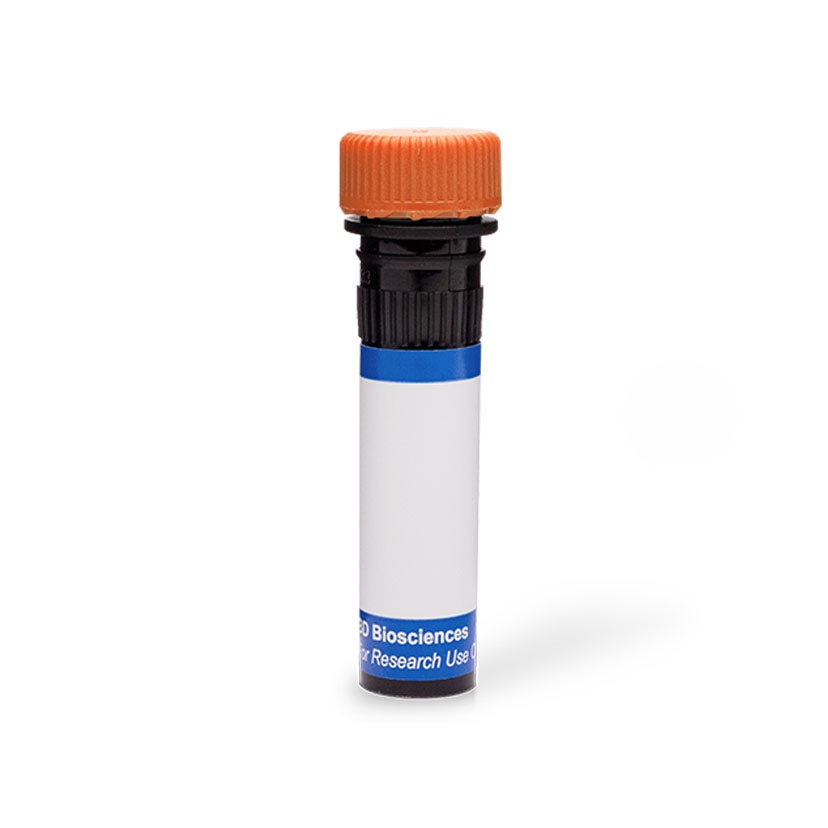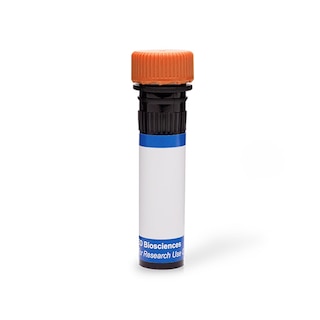Old Browser
Looks like you're visiting us from United States.
Would you like to stay on the current country site or be switched to your country?
BD Horizon™ PE-CF594 Mouse Anti-Mouse NK-1.1
克隆 PK136 (RUO)

Two-color flow cytometric analysis of NK-1.1 expression on mouse splenocytes. C57BL/6 mouse splenic leucocytes were preincubated with Purified Rat Anti-Mouse CD16/CD32 antibody (Mouse BD Fc Block™) (Cat. No. 553141/553142). The cells were then stained with PE Hamster Anti-Mouse CD3e antibody (Cat. No. 553064/553063/561824) and either BD Horizon™ PE-CF594 Mouse IgG2a, κ Isotype Control (Cat. No. 562306, Left Panel) or BD Horizon™ PE-CF594 Mouse Anti-Mouse NK-1.1 (Cat. No. 562864; Right Panel). Two-color flow cytometric dot plots show the correlated expression patterns of NK1.1 (or Ig Isotype control staining) versus CD3e for gated events with the forward and side light-scatter characteristics of viable splenic leucocytes. Flow cytometric analysis was performed using a BD™ LSR II Flow Cytometer System.

Two-color flow cytometric analysis of NK-1.1 expression on mouse splenocytes. C57BL/6 mouse splenic leucocytes were preincubated with Purified Rat Anti-Mouse CD16/CD32 antibody (Mouse BD Fc Block™) (Cat. No. 553141/553142). The cells were then stained with PE Hamster Anti-Mouse CD3e antibody (Cat. No. 553064/553063/561824) and either BD Horizon™ PE-CF594 Mouse IgG2a, κ Isotype Control (Cat. No. 562306, Left Panel) or BD Horizon™ PE-CF594 Mouse Anti-Mouse NK-1.1 (Cat. No. 562864; Right Panel). Two-color flow cytometric dot plots show the correlated expression patterns of NK1.1 (or Ig Isotype control staining) versus CD3e for gated events with the forward and side light-scatter characteristics of viable splenic leucocytes. Flow cytometric analysis was performed using a BD™ LSR II Flow Cytometer System.



Two-color flow cytometric analysis of NK-1.1 expression on mouse splenocytes. C57BL/6 mouse splenic leucocytes were preincubated with Purified Rat Anti-Mouse CD16/CD32 antibody (Mouse BD Fc Block™) (Cat. No. 553141/553142). The cells were then stained with PE Hamster Anti-Mouse CD3e antibody (Cat. No. 553064/553063/561824) and either BD Horizon™ PE-CF594 Mouse IgG2a, κ Isotype Control (Cat. No. 562306, Left Panel) or BD Horizon™ PE-CF594 Mouse Anti-Mouse NK-1.1 (Cat. No. 562864; Right Panel). Two-color flow cytometric dot plots show the correlated expression patterns of NK1.1 (or Ig Isotype control staining) versus CD3e for gated events with the forward and side light-scatter characteristics of viable splenic leucocytes. Flow cytometric analysis was performed using a BD™ LSR II Flow Cytometer System.
Two-color flow cytometric analysis of NK-1.1 expression on mouse splenocytes. C57BL/6 mouse splenic leucocytes were preincubated with Purified Rat Anti-Mouse CD16/CD32 antibody (Mouse BD Fc Block™) (Cat. No. 553141/553142). The cells were then stained with PE Hamster Anti-Mouse CD3e antibody (Cat. No. 553064/553063/561824) and either BD Horizon™ PE-CF594 Mouse IgG2a, κ Isotype Control (Cat. No. 562306, Left Panel) or BD Horizon™ PE-CF594 Mouse Anti-Mouse NK-1.1 (Cat. No. 562864; Right Panel). Two-color flow cytometric dot plots show the correlated expression patterns of NK1.1 (or Ig Isotype control staining) versus CD3e for gated events with the forward and side light-scatter characteristics of viable splenic leucocytes. Flow cytometric analysis was performed using a BD™ LSR II Flow Cytometer System.

Two-color flow cytometric analysis of NK-1.1 expression on mouse splenocytes. C57BL/6 mouse splenic leucocytes were preincubated with Purified Rat Anti-Mouse CD16/CD32 antibody (Mouse BD Fc Block™) (Cat. No. 553141/553142). The cells were then stained with PE Hamster Anti-Mouse CD3e antibody (Cat. No. 553064/553063/561824) and either BD Horizon™ PE-CF594 Mouse IgG2a, κ Isotype Control (Cat. No. 562306, Left Panel) or BD Horizon™ PE-CF594 Mouse Anti-Mouse NK-1.1 (Cat. No. 562864; Right Panel). Two-color flow cytometric dot plots show the correlated expression patterns of NK1.1 (or Ig Isotype control staining) versus CD3e for gated events with the forward and side light-scatter characteristics of viable splenic leucocytes. Flow cytometric analysis was performed using a BD™ LSR II Flow Cytometer System.

Two-color flow cytometric analysis of NK-1.1 expression on mouse splenocytes. C57BL/6 mouse splenic leucocytes were preincubated with Purified Rat Anti-Mouse CD16/CD32 antibody (Mouse BD Fc Block™) (Cat. No. 553141/553142). The cells were then stained with PE Hamster Anti-Mouse CD3e antibody (Cat. No. 553064/553063/561824) and either BD Horizon™ PE-CF594 Mouse IgG2a, κ Isotype Control (Cat. No. 562306, Left Panel) or BD Horizon™ PE-CF594 Mouse Anti-Mouse NK-1.1 (Cat. No. 562864; Right Panel). Two-color flow cytometric dot plots show the correlated expression patterns of NK1.1 (or Ig Isotype control staining) versus CD3e for gated events with the forward and side light-scatter characteristics of viable splenic leucocytes. Flow cytometric analysis was performed using a BD™ LSR II Flow Cytometer System.




监管状态图例
未经BD明确书面授权,严禁使用未经许可的任何商品。
准备和存储
商品通知
- Since applications vary, each investigator should titrate the reagent to obtain optimal results.
- Source of all serum proteins is from USDA inspected abattoirs located in the United States.
- An isotype control should be used at the same concentration as the antibody of interest.
- Please refer to www.bdbiosciences.com/us/s/resources for technical protocols.
- Please observe the following precautions: Absorption of visible light can significantly alter the energy transfer occurring in any tandem fluorochrome conjugate; therefore, we recommend that special precautions be taken (such as wrapping vials, tubes, or racks in aluminum foil) to prevent exposure of conjugated reagents, including cells stained with those reagents, to room illumination.
- Caution: Sodium azide yields highly toxic hydrazoic acid under acidic conditions. Dilute azide compounds in running water before discarding to avoid accumulation of potentially explosive deposits in plumbing.
- For fluorochrome spectra and suitable instrument settings, please refer to our Multicolor Flow Cytometry web page at www.bdbiosciences.com/colors.
- Texas Red is a registered trademark of Molecular Probes, Inc., Eugene, OR.
- CF™ is a trademark of Biotium, Inc.
- When excited by the yellow-green (561-nm) laser, the fluorescence may be brighter than when excited by the blue (488-nm) laser.
- This product is provided under an Agreement between BIOTIUM and BD Biosciences. The manufacture, use, sale, offer for sale, or import of this product is subject to one or more patents or pending applications owned or licensed by Biotium, Inc. This product, and only in the amount purchased by buyer, may be used solely for buyer’s own internal research, in a manner consistent with the accompanying product literature. No other right to use, sell or otherwise transfer (a) this product, or (b) its components is hereby granted expressly, by implication or by estoppel. This product is for research use only. Diagnostic uses require a separate license from Biotium, Inc. For information on purchasing a license to this product including for purposes other than research, contact Biotium, Inc., 3159 Corporate Place, Hayward, CA 94545, Tel: (510) 265-1027. Fax: (510) 265-1352. Email: btinfo@biotium.com.
- Because of the broad absorption spectrum of the tandem fluorochrome, extra care must be taken when using multi-laser cytometers, which may directly excite both PE and CF™594.
配套商品






In the mouse, at least three members of the Klrb (Killer cell lectin-like receptor, subfamily b; formerly NKR-P1) gene family have been identified (Klrb1a/NKR-P1A, Klrb1b/NKR-P1B, and Klrb1c/NKR-P1C); but in the human gene family, a single homologue has been designated KLRB1, NKR-P1A, or CD161. The KLRB1/NKR-P1 family of proteins are type-II-transmembrane C-type lectin receptors. KLRB1C/NKR-P1C activates NK-cell cytotoxicity, while KLRB1B/NKR-P1B functions as an inhibitory receptor. KLRB1B/NKR-P1B protein has intracellular Immunoreceptor Tyrosine-based Inhibitory Motif (ITIM), while KLRB1C/NKR-P1C lacks ITIM and activates via association with Fc Receptor γ chain. Strikingly, KLRB1B/NKR-P1B and KLRB1C/NKR-P1C share 96% amino acid sequence identity in their extracellular C-type lectin domains. The PK136 antibody reacts with the NK-1.1 surface antigen (CD161c) encoded by the Klrb1c/NKR-P1C gene expressed on natural killer (NK) cells in selected strains of mice (eg, C57BL, FVB/N, NZB, but not A, AKR, BALB/c, CBA/J, C3H, C57BR, C58, DBA/1, DBA/2, NOD, SJL, 129) and the CD161b antigen encoded by the Klrb1b/NKR-P1B gene expressed only on Swiss NIH and SJL mice, but not on C57BL/6. Expression of KLRB1C/NKR-P1C protein is correlated with the ability to lyse tumor cells in vitro and to mediate rejection of bone marrow allografts. The NK-1.1 marker is useful in defining NK cells; however, the antigen is also expressed on a rare, specialized population of T lymphocytes (NK-T cells) and some cultured monocytes. Plate-bound PK136 mAb, in combination with low concentrations of IL-2, induces proliferation of a subset of NK cells.
This antibody is conjugated to BD Horizon™ PE-CF594, which has been developed exclusively by BD Biosciences as a better alternative to PE-Texas Red®. PE-CF594 excites and emits at similar wavelengths to PE-Texas Red® yet exhibits improved brightness and spectral characteristics. Due to PE having maximal absorption peaks at 496 nm and 564 nm, PE-CF594 can be excited by the blue (488-nm), green (532-nm) and yellow-green (561-nm) lasers and can be detected with the same filter set as PE-Texas Red® (eg 610/20-nm filter).

研发参考 (11)
-
Arase N, Arase H, Park SY, Ohno H, Ra C, Saito T. Association with FcRgamma is essential for activation signal through NKR-P1 (CD161) in natural killer (NK) cells and NK1.1+ T cells. J Exp Med. 1997; 186(12):1957-1963. (Clone-specific: Cytotoxicity, Flow cytometry, Fluorescence activated cell sorting, Functional assay, Immunofluorescence, Immunoprecipitation, Stimulation). 查看参考
-
Carlyle JR, Martin A, Mehra A, Attisano L, Tsui FW, Zuniga-Pflucker JC. Mouse NKR-P1B, a novel NK1.1 antigen with inhibitory function. J Immunol. 1999; 162(10):5917-5923. (Clone-specific: Cytotoxicity, Flow cytometry, Immunoprecipitation, Inhibition, Stimulation). 查看参考
-
Giorda R, Trucco M. Mouse NKR-P1. A family of genes selectively coexpressed in adherent lymphokine-activated killer cells. J Immunol. 1991; 147(5):1701-1708. (Biology). 查看参考
-
Koo GC, Dumont FJ, Tutt M, Hackett J Jr, Kumar V. The NK-1.1(-) mouse: a model to study differentiation of murine NK cells. J Immunol. 1986; 137(12):3742-3747. (Clone-specific: Flow cytometry, In vivo exacerbation). 查看参考
-
Koo GC, Peppard JR. Establishment of monoclonal anti-Nk-1.1 antibody. Hybridoma. 1984; 3(3):301-303. (Immunogen: Cytotoxicity, Flow cytometry). 查看参考
-
Kung SK, Su RC, Shannon J, Miller RG. The NKR-P1B gene product is an inhibitory receptor on SJL/J NK cells. J Immunol. 1999; 162(10):5876-5887. (Clone-specific: Activation, Calcium Flux, Flow cytometry, Fluorescence activated cell sorting, Immunoprecipitation, Inhibition, Stimulation). 查看参考
-
Lanier LL. Natural killer cells: from no receptors to too many. Immunity. 1997; 6(4):371-378. (Biology). 查看参考
-
Reichlin A, Yokoyama WM. Natural killer cell proliferation induced by anti-NK1.1 and IL-2. Immunol Cell Biol. 1998; 76(2):143-152. (Clone-specific: Activation, Cytotoxicity, Functional assay, Stimulation). 查看参考
-
Sentman CL, Kumar V, Koo G, Bennett M. Effector cell expression of NK1.1, a murine natural killer cell-specific molecule, and ability of mice to reject bone marrow allografts. J Immunol. 1989; 142(6):1847-1853. (Clone-specific: Flow cytometry, Immunofluorescence). 查看参考
-
Vicari AP, Zlotnik A. Mouse NK1.1+ T cells: a new family of T cells. Immunol Today. 1996; 17(2):71-76. (Biology). 查看参考
-
Yokoyama WM, Seaman WE. The Ly-49 and NKR-P1 gene families encoding lectin-like receptors on natural killer cells: the NK gene complex. Annu Rev Immunol. 1993; 11:613-635. (Biology). 查看参考
Please refer to Support Documents for Quality Certificates
Global - Refer to manufacturer's instructions for use and related User Manuals and Technical data sheets before using this products as described
Comparisons, where applicable, are made against older BD Technology, manual methods or are general performance claims. Comparisons are not made against non-BD technologies, unless otherwise noted.
For Research Use Only. Not for use in diagnostic or therapeutic procedures.